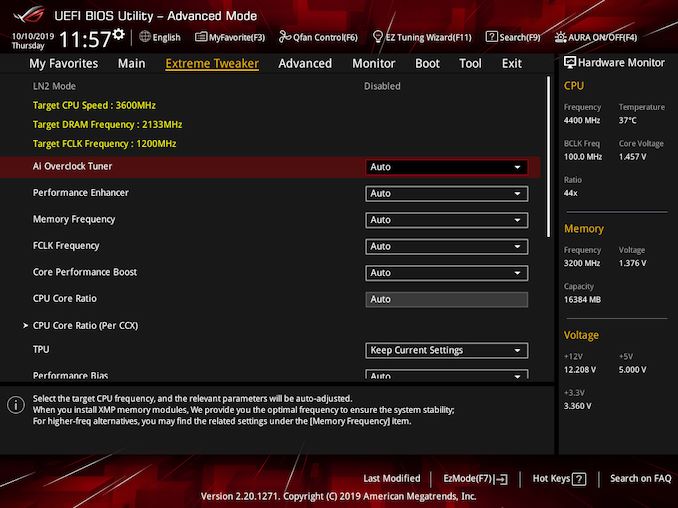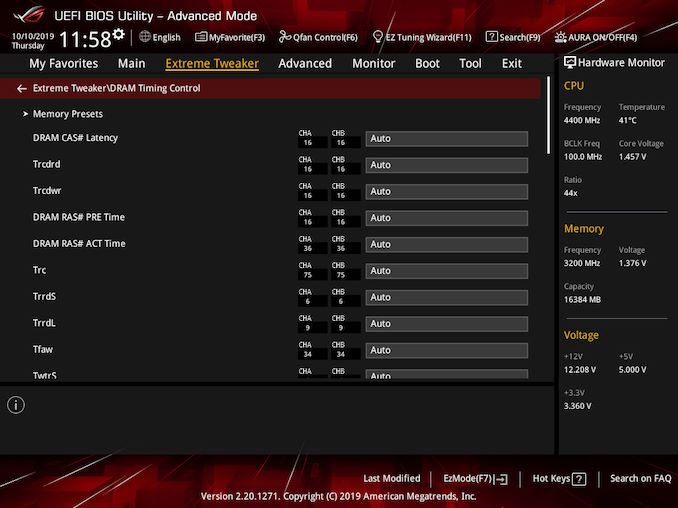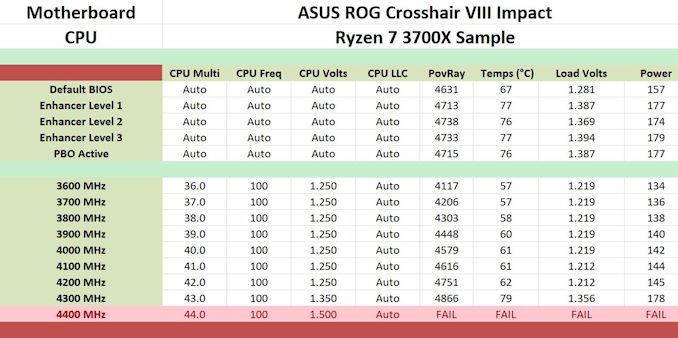The ASUS ROG Crosshair VIII Impact: A Sharp $430 Impulse on X570
by Gavin Bonshor on October 25, 2019 11:30 AM ESTOverclocking Ryzen 3000
Experience with the ASUS ROG Crosshair VIII Impact
Overclocking with the ASUS ROG firmware on the ROG Crosshair VIII Impact is quite pleasant as all of the overclocking related options are located in the Extreme Tweaker menu. For most users looking to overclock the Ryzen 3000 processors, the primary settings to change are the CPU Core Frequency, CPU VCore voltage; memory overclocking can be done automatically by enabling the X.M.P memory profile which ASUS calls D.O.C.P. To make fine-tuned adjustments, ASUS includes plenty of voltage and SoC options, although the ROG Crosshair VIII Impact doesn't support the integrated graphics of the Ryzen APUs as there are no video outputs on the rear panel.
There are no CPU overclocking presets to select from, but users can enable one of the memory presets which are a good starting point for high-binned memory; not only is this expensive but due to the locked Infinity Fabric clock-speed, it becomes less effective without making FCLK adjustments beyond using DDR4-3600 memory. Users can use the firmware fine-tune the primary, secondary, and tertiary memory latencies in the DRAM Timing Control section.
Users looking to make performance-enhancing changes will need to rely on manually overclocking the processors. This is something ASUS ROG is very competent at providing with a whole host of customizable frequency, voltage, and power-related settings for users to chomp on. The firmware on the ASUS ROG Crosshair VIII Impact is well equipped for overclocking, it's very responsive to use and works well. For the more extreme overclockers, there is plenty to appreciate with lots of scope for LN2 cooling with its overclocker's toolkit, an LN2 specific mode, and lots of extreme memory profiles to use as a starting point.
Overclocking Methodology
Our standard overclocking methodology is as follows. We select the automatic overclock options and test for stability with POV-Ray and OCCT to simulate high-end workloads. These stability tests aim to catch any immediate causes for memory or CPU errors.
For manual overclocks, based on the information gathered from the previous testing, starts off at a nominal voltage and CPU multiplier, and the multiplier is increased until the stability tests are failed. The CPU voltage is increased gradually until the stability tests are passed, and the process repeated until the motherboard reduces the multiplier automatically (due to safety protocol) or the CPU temperature reaches a stupidly high level (105ºC+). Our testbed is not in a case, which should push overclocks higher with fresher (cooler) air.
Overclocking Results
The ASUS ROG Crosshair VIII Impact is very efficient with its VDroop at all of the tested frequencies with the firmware set to the auto LLC setting. From 3.6 GHz to 4.2 GHz with 1.250 V set on the CPU VCore in the firmware, we experienced around 0.038 V of VDroop compensation. This not only reduces the overall power consumption at maximum load, but it also helps to reduce CPU temperatures. Moving up to 4.3 GHz at 1.350 V on the CPU VCore, we saw a slight increase to this value at load with a CPU VCore of 1.356 V. We know our Ryzen 7 3700X processor is capable of running 4.3 GHz with slightly less load VCore, but it seems the firmware was playing it safe with a focus on overclocking stability. Our POV-Ray benchmark performance was consistent as we went up in each 100 MHz frequency stepping. The limit on our Ryzen 7 3700X with our testbed cooler is 4.3 GHz, and the Impact couldn't get our chip stable at 4.4 GHz regardless of the voltage we applied.
When it comes to Precision Boost Overdrive performance, and unlike in our review of the GIGABYTE X570 Aorus Xtreme review, the ASUS ROG Crosshair VIII Impact default performance leads us to believe that at default settings, some element of PBO is applied. The performance at default settings in our testing is the equivalent of our testing at 4.1 GHz, which shows the CPU is boosting higher at default settings than some vendors models. We did expect to see some CPU overclocking presets on this model, but this is something ASUS may add at a later date, but it seems the best way to achieve maximum performance is to manually overclock the processor.













59 Comments
View All Comments
Holliday75 - Friday, October 25, 2019 - link
Been a bit disappointed in Zen2, X570/PCI4 boards in general and fans certainly do not help. Bleeding edge for sure, but bleeding edge issues as well. My I7-3770k (longest lasting CPU I ever had) is going to have to last another year. Hoping Zen3 things settle down and the tech is mature enough to jump on board.hansmuff - Friday, October 25, 2019 - link
On any decent board you can set a fan curve and effectively silence the fan. On my Gigabyte X570 it never runs at all even in intense benchmark or gaming sessions. I do agree that having fans back on motherboards is just crap and should have been avoided. I can only guess that there are edge cases that made AMD demand this level of cooling, I just haven't found it yet.Korguz - Friday, October 25, 2019 - link
all these people complaining about the chipset fan.. the 2 fans for my cpu cooler would probably drown it out, and is probably louder, let alone the other 6 case fans i have in my case...PeachNCream - Saturday, October 26, 2019 - link
Concerns from most people are about fan longevity and not noise, although I will readily admit that after using several low end laptops that rely purely on passive cooling and eMMC or other form of solid state storage, the silence is difficult to give up in exchange for what feels like a archaic, non-portable box filled with fans. That's really where I'm at in computing these days. My needs, even gaming, are met by passively cooled, tiny laptops and I really see no reason to go back to desktop computers, dedicated GPUs, and systems that need cooling fans.Korguz - Saturday, October 26, 2019 - link
i have fans from 5+ years ago, spinning 8-10 hrs a day, that still work just fine, i even booted up an old A64 fx60, with an Asus board, that has a chipset fan, and it still works just fine. so i dont get the longevity aspect..sorry PeachNcream, but you always comparing a desktop vs a notebook, kind of makes your view moot. a desktop will, for the most part, always be louder then a notebook, and the fact that you use passively cooled ones on top of that, further makes it moot
you needs may be met by such a laptop, but, what games do you play???????? that's the key, my guess, nothing that was released in the last few years if they run fun on such a laptop, or facebook type games. i have some old games, that i bet, would make your laptop cry, and on the one i have, to get them to play, its medium graphics or less. but each use case is different, but also, cant compare them, equally.
PeachNCream - Saturday, October 26, 2019 - link
Your older motherboard is a sample size of one.TheinsanegamerN - Sunday, October 27, 2019 - link
I have a nforce 2 motherboard running windows xp, and it has had its chipset fan replaced several times before getting a large heatsink upgrade to be rid of that annoyance.I vividly remember my pentium II/III PCs getting new fans every year, because those tiny fans would gum up and become rattly garbage.
I still replace laptop fans on the regular that are 3-4 years old and are used on a daily basis.
There is a reason so many people have an aversion to tiny fans. They are junk.
Oliseo - Sunday, October 27, 2019 - link
If you've no interest, why read the articles, let alone argue with people in the comments.AshlayW - Monday, October 28, 2019 - link
No one cares that you use a passive mobile potato for your Facebook gaming needs. This website is about hardware enthusiastsPeachNCream - Wednesday, October 30, 2019 - link
Ah, I understand now. Because I don't use a computer in the same way you do and my opinion threatens yours, it's clearly the case that we need to make up rules here at Anandtech that disallow somone from reading an article until they can prove that it is directly relevant to the computing choices they currently make.What a flawed method of arguing -- of all things, over the presence of a small cooling fan. Feel threatned about a couple of 30mm fans that might fail? Defend the lack of noise! On wait, it's isn't about noise?! You're not allowed to be here arguing in the first place with your point about fan failures!
What children you're acting like over your toys and hobbies.